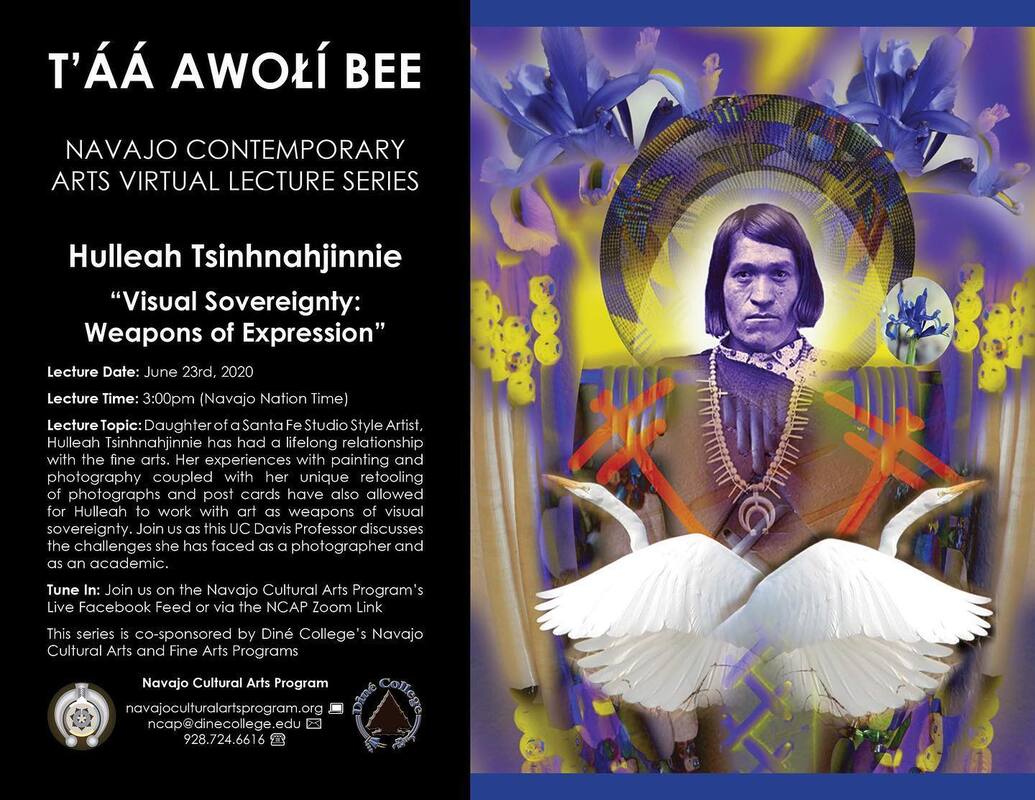Brandon LesterNAS111: Introduction to Native American Studies, Student
Hulleah Tsinhnahjinnie is a 2002 graduate from the University of California, Irvine, where she pursued a Master’s Degree in Studio Arts. Tsinhnahjinnie is also a photographer, curator, Professor in Native American Studies at University of California, Davis, and currently the Director of the CN Gorman Museum. Tsinhnahjinnie is Seminole-Muskagee-Navajo, Through our clanship we have no relation, but through K’é I will address her as shinálí (my paternal grandmother). She was born into the Bear and Raccoon Clans of the Seminole and Muskagee Nations, and born for the Tsinajinnie clan of the Navajo Nation. Tsinhnahjinnie has a passion for Native American Arts and re-appropriating 19th century old photos of Native subjects and by her methods she changes the perspective of what the original photos were meant for. She uses the fusion of photography and contemporary digital art to challenge or change Native stereotypes, defy political concepts, and through her work she pioneered expanding the creativity of Natives to fully express their ideas and thoughts in an open and safe creative space. Tsinhnahjinnie is also a apart of the LGBTQ+ community and me also being a part of that community instantly I felt that bond through her interview and so, I thought – why not have her be a part of my blog and write about her thoughts on Indigenous art, identity and language! I chose to select Hulleah because through her interview she allowed me to look at Native arts and look beyond the image and analyze the image and flip the perspective and take control of the visuals. As a photographer, she saw the power of images through photography, the power of possible change for the better. I also chose to write about Hulleah because she mentioned that she identifies as two-spirit, I too, identify as two-spirit and some of her work is inspired from how she identifies as a two-spirit Native woman. Tsinhnahjinnie archive ranges from the San Francisco Native American gay communities to the protests at Alcatraz, she says “I didn’t not realize I was making and expanding my archive.” Her main focus was to document events of different Indigenous communities to continue telling their stories through images of people doing incredible things. Her Indigenous identity impacted her art by her telling the story of We’Wha, The Beloved. She explained that “We’Wha lived her life as a woman, born as man and buried as man. But during her time here on the earth she was a woman. She was an “in-between”, that she was able to go out to the outside world and brought back what she considered to be beneficial to her tribe, and teach tribal members.” We’Wha was always involved with her community, helped with ceremonies, and she was highly respected within her Zuni community from 1860-1898. Tsinhnahninnie says that “We’Wha was two-spirit and when I needed inspiration, I look at this image” (We’Wha: The Beloved). In addition, her Indigenous identity impacted her art by literally being born into the world of arts because her father was a painter and photographer. Her father was a student at the Institute of American Indian Arts and his classmates used to come to their house on a Saturday to paint and tell stories as she listened to their stories. Tsinhnahjinnie herself attended Rough Rock Community School as a child, at that time Rough Rock Community School was the one of first schools to add Navajo Language to their curriculum and her father was the person to illustrate the Navajo textbooks, and a team of Native artists, educators, and community members created a system to take control of their image to teach Navajo culture and language to children that builds stronger Indigenous communities for future generations. You know when politicians, well-known photographers, visitors from First Nation in Canada, and visitors from around the world wanting to observe how the first bi-lingual school was doing is only a sign of building a stronger community. She also stated that “having years of archives of photographs from all her travels and being in the Bay area, sometimes people would come up to her and ask her if she might have a picture of their grandparents during the years they were in school or at events.” She said she usually would have the pictures that were requested and that in itself helps build a stronger community for Indigenous nations. Hulleah left me with a stronger insight for how I observe the arts and how within my identity as an Indigenous person, I can have control of my image and my perception of that image. Also, her manipulation of photographs has the ability to re-interpret the colonial message and to send a message of our own to flip the perspective is such a creative but factualistic approach is innovative and it opened up my creativity and mind to take control of my image through visual sovereignty. Hulleah is such an inspiration to me and after her interview I felt the passion she had for her work and I will always carry with me what she said about controlling one’s image “nobody ever wants to be imaged as a loser, nobody wants to be imaged as defeated, and nobody wants to be imaged as less than. So, taking control of that means a lot and that’s a step taking control of one’s image.”
0 Comments
Leave a Reply. |
Categories
All
Archives
October 2021
|
SocialsALL PHOTOS IMAGES ARE COPYRIGHT PROTECTED. PHOTO IMAGES USE IS SUBJECT TO PERMISSION BY THE NAVAJO CULTURAL ARTS PROGRAM. NO FORM OF REPRODUCTION IS PERMITTED WITHOUT WRITTEN PERMISSION FROM THE NAVAJO CULTURAL ARTS PROGRAM. |
Featured Pages |

